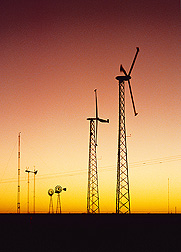This page has been archived and is being provided for reference purposes only. The page is no longer being updated, and therefore, links on the page may be invalid.
Blending Wind and Solar Meets Peak Energy Demands
By Don ComisAugust 12, 2010
In parts of Texas and California, a good match between renewable energy production and peak energy demands could be obtained by combining wind power with solar power, according to a U.S. Department of Agriculture (USDA) scientist.
A better blending of solar and wind power, combined with a way to store excess energy, should increase the use of renewable energy for California, Texas and the rest of the nation, according to a study by Agricultural Research Service (ARS) agricultural engineer Brian Vick at the agency's Renewable Energy and Manure Management Research Unit in Bushland, Texas. ARS is USDA's principal intramural scientific research agency.
Vick discovered that in the Texas Panhandle and West Texas, as well as in northern and southern California, there is almost an exact mismatch between wind power production and peak energy demands over a 24-hour period. In these locations, at the heights of modern wind turbines, winds are lowest at mid-day, when power demands are greatest. In Texas, there is also a seasonal mismatch: The winds are weakest in the summer, when power demands are highest.
But the sun's rays are most intense at mid-day and in summer months.
Texas is the top state for wind-generated electricity production, with Iowa ranking second and California third. California is the leader in solar-generated electricity production.
The most efficient storage system is one being used in solar thermal power plants, where the sun's heat is used to heat water or other fluids. The fluids are kept hot long after the sun goes down, ready to be used later to produce steam to generate electricity.
The excess electricity generated by wind in the late night and early morning hours could be pumped into the grid and removed by storage facilities (like pumped-storage hydroelectricity or compressed-air energy storage facilities) to match the utility loading in the daytime.
Vick and colleagues at Bushland have tested and helped on the design of wind turbines and hybrid wind/solar systems for off-grid rural applications, residential grid systems and wind farms for the U.S. Department of Energy. They also have designed and tested wind/biodiesel hybrid systems that powered simulated electrical grids of remote locations like Alaskan fishing villages.
At this year's American Wind Energy Association conference in Dallas, Texas, Vick presented results on combining wind farms with solar thermal power plants, including storage for the additional states of Arizona, Colorado, Nevada, New Mexico and Utah.
This research supports the USDA priority of developing new sources of alternative energy.

